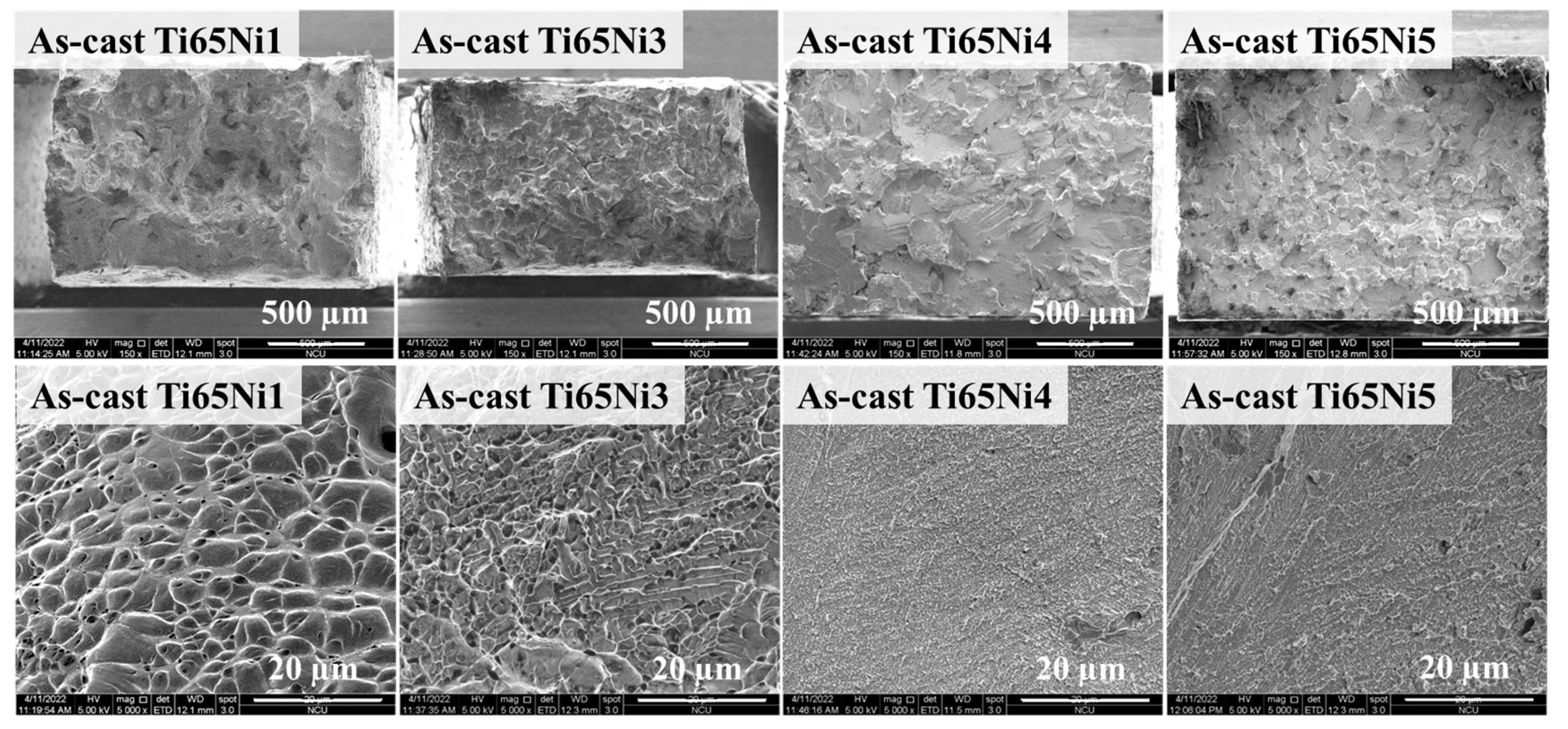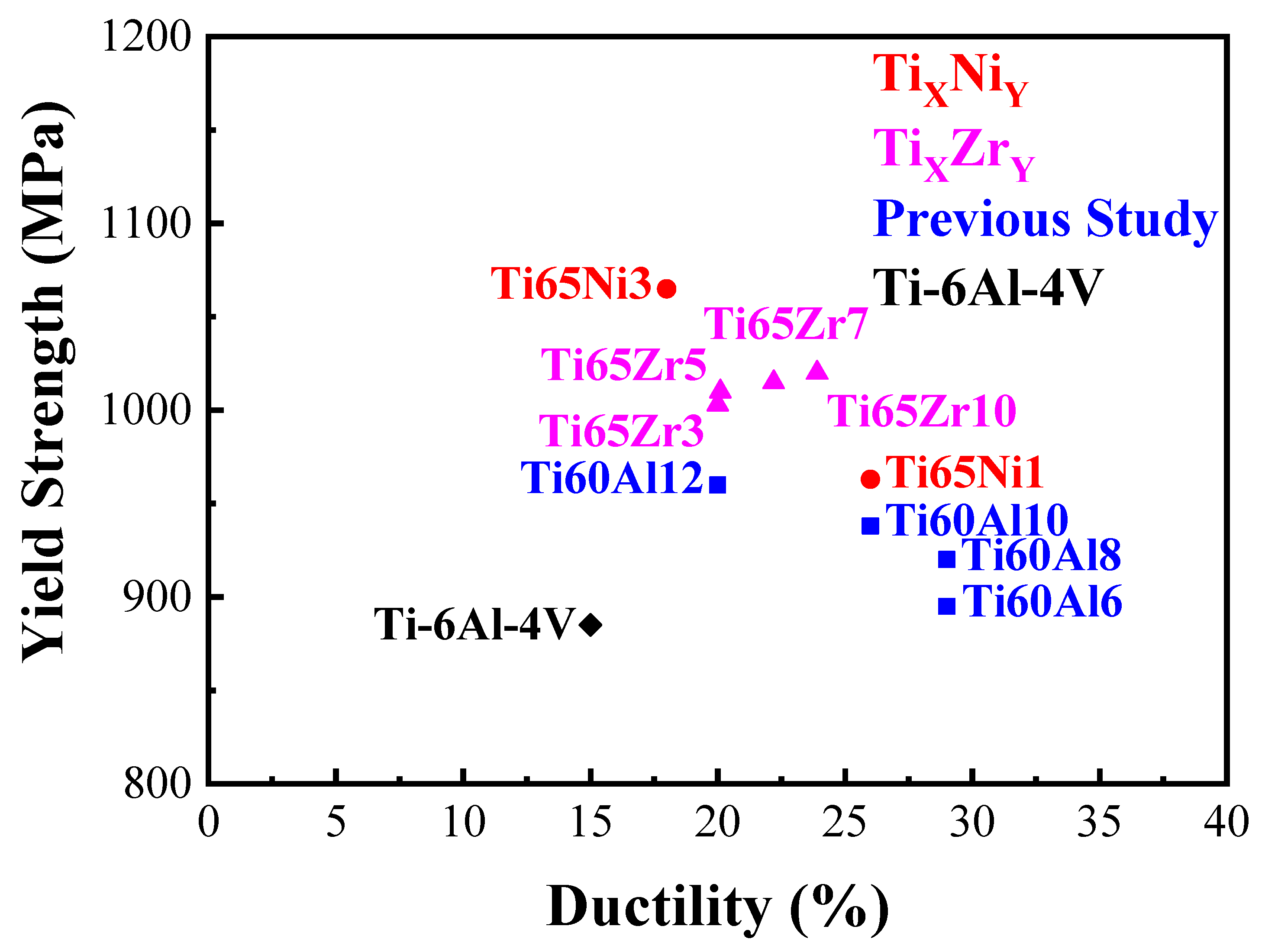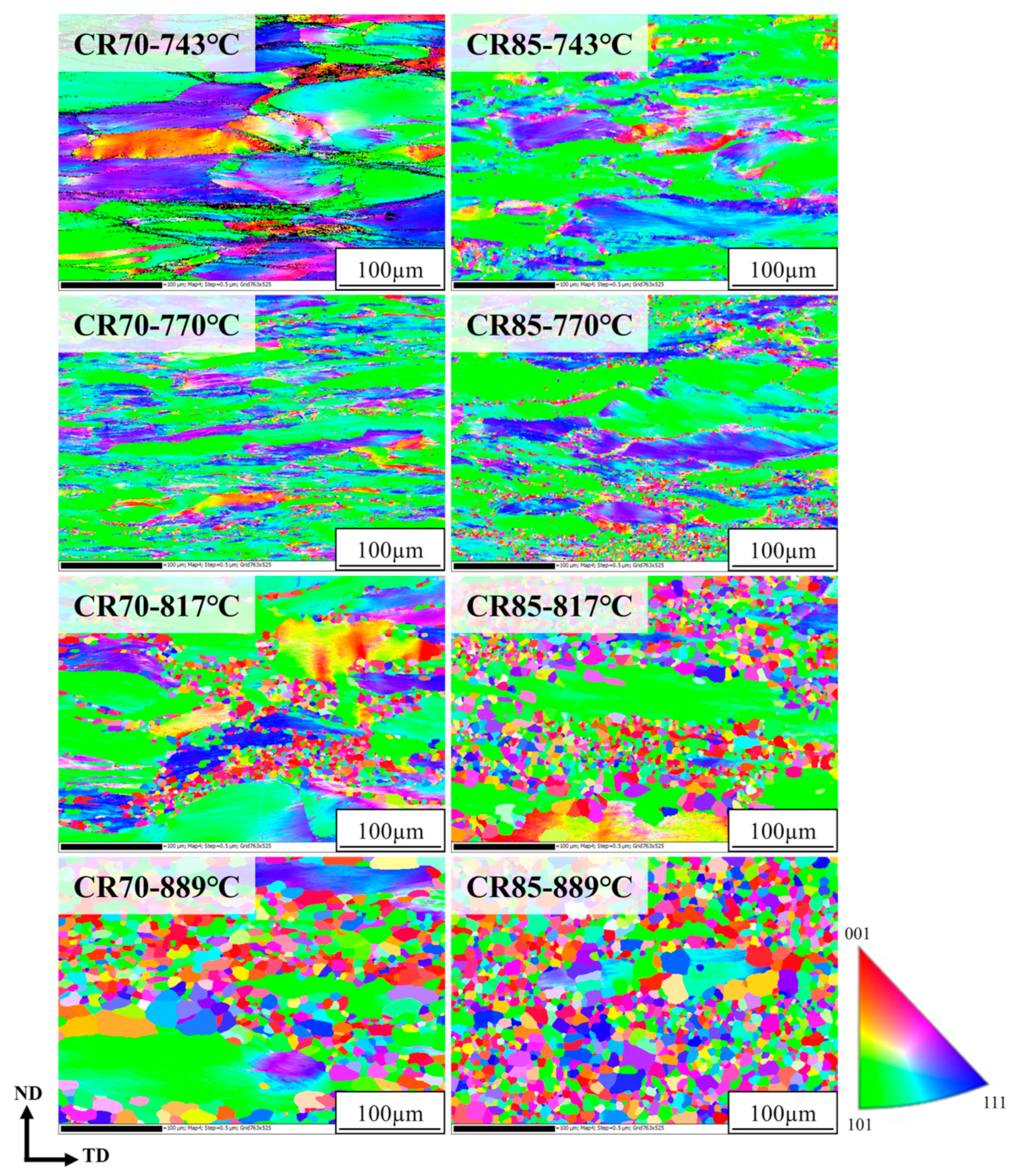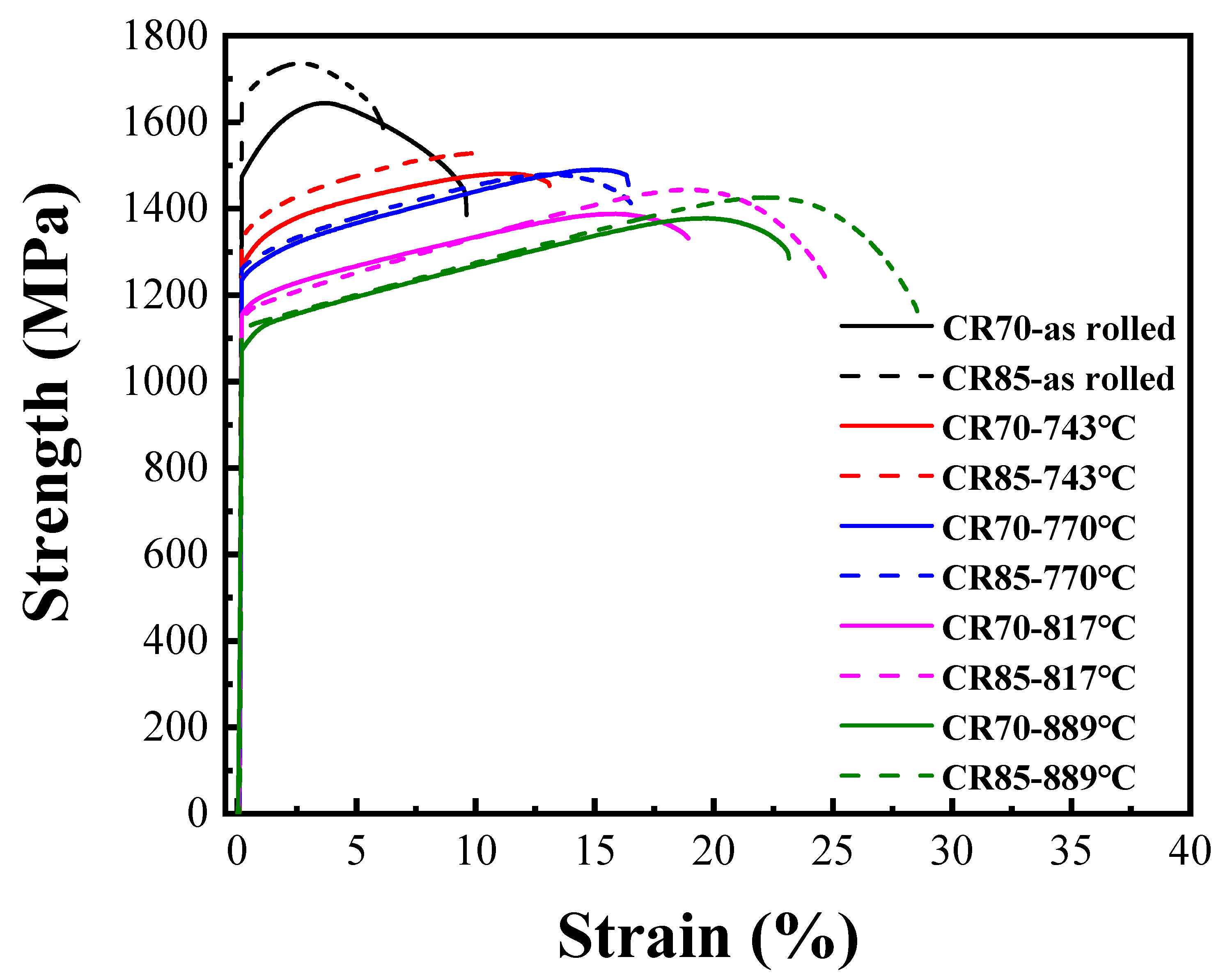Enhancing the Strength and Ductility Synergy of Lightweight Ti-Rich Medium-Entropy Alloys through Ni Microalloying
Abstract
:1. Introduction
2. Experimental Procedure
2.1. Material Design
2.2. Thermo-Mechanical Treatment
2.3. Microstructure Characterization
2.4. Mechanical Testing
3. Results and Discussion
3.1. Characterization of As-Cast Tix(AlCrNbV)100−x−yNiy (TiXNiY) MEAs
3.2. Performance of the Ti65Ni3 MEA after TMT
4. Conclusions
- The density of the Tix(AlCrNbV)100−x−yNiy series MEAs ranged from 5.02 to 5.12 g/cm3, closely aligning with the predetermined target of approximately 5 g/cm3. Notably, all MEAs exhibited a single BCC structure in both the as-cast state and after-TMT processing.
- Microalloying with Ni could not only effectively improve strength but also preserve the favorable ductility in the Ti65−x(AlCrNbV)35Nix MEAs. The as-cast Ti65Ni3 MEA exhibited optimal strength and ductility. However, higher Ni content led to the embrittlement of the MEA.
- The Ti65Ni3 MEA subjected to CR70 and CR85 processing and annealed for 30 s exhibited high yield strength (>1250 MPa) and ductility (>13%). In particular, the Ti65Ni3 MEA subjected to CR85 processing and annealed for 30s exhibited a specific yield strength of 264 MPa·cm3/g, specific tensile strength of 300 MPa·cm3/g, and ductility of >13%.
Author Contributions
Funding
Institutional Review Board Statement
Informed Consent Statement
Data Availability Statement
Acknowledgments
Conflicts of Interest
References
- ASM International Handbook Committee. Properties and Selection: Irons, Steels, and High-Performance Alloys; ASM International: Materials Park, OH, USA, 1990; Volume 1. [Google Scholar]
- Aluminum-Lithium Alloys Fight Back. Available online: https://aluminiuminsider.com/aluminium-lithium-alloys-fight-back/ (accessed on 20 June 2021).
- Springer, H.; Baron, C.; Szczepaniak, A.; Uhlenwinkel, V.; Raabe, D. Stiff, light, strong and ductile: Nano-structured High Modulus Steel. Sci. Rep. 2017, 7, 2757. [Google Scholar] [CrossRef] [PubMed]
- Huang, K.H.; Yeh, J.W. A Study on Multicomponent Alloy Systems Containing Equal-Mole Elements; Department of Materials Science and Engineering, National Tsing Hua University: Hsinchu, Taiwan, 1996. [Google Scholar]
- Yeh, J.W.; Chen, S.K.; Lin, S.J.; Gan, J.Y.; Chin, T.S.; Shun, T.T.; Tsau, C.H.; Chang, S.Y. Nanostructure High-Entropy Alloys with Multiple Principle Elements: Novel Alloy Design Concepts and Outcomes. Adv. Eng. Mater. 2004, 6, 299–303. [Google Scholar] [CrossRef]
- Yeh, J.W. Recent progress in high-entropy alloys. Ann. Chim. Sci. Mat. 2006, 31, 633–648. [Google Scholar] [CrossRef]
- Zhou, Y.; Zhou, D.; Jin, X.; Zhang, L.; Du, X.; Li, B. Design of non-equiatomic medium-entropy alloys. Sci. Rep. 2018, 8, 1236. [Google Scholar] [CrossRef] [PubMed]
- Ma, D.; Yao, M.; Pradeep, K.; Tasan, C.; Springer, H.; Raabe, D. Phase stability of non-equiatomic CoCrFeMnNi high entropy alloys. Acta Mater. 2015, 98, 288–296. [Google Scholar] [CrossRef]
- Choi, M.; Ondicho, I.; Park, N.; Tsuji, N. Strength–ductility balance in an ultrafine-grained non-equiatomic Fe50(CoCrMnNi)50 medium-entropy alloy with a fully recrystallized microstructure. J. Alloys Compd. 2019, 780, 959–966. [Google Scholar] [CrossRef]
- Wang, S.; Chen, Z.; Zhang, P.; Zhang, K.; Chena, C.L.; Shen, B.L. Influence of Al content on high temperature oxidation behavior of AlxCoCrFeNiTi0.5 high entropy alloys. Vacuum 2019, 163, 263–268. [Google Scholar] [CrossRef]
- Youssef, K.; Zaddach, A.J.; Niu, C.; Irving, D.L.; Koch, C.C. A Novel Low-Density, High-Hardness, High-entropy Alloy with Close-packed Single-phase Nanocrystalline Structures. Mater. Res. Lett. 2014, 3, 95–99. [Google Scholar] [CrossRef]
- Yao, M.; Pradeep, K.; Tasan, C.; Raabe, D. A novel, single phase, non-equiatomic FeMnNiCoCr high entropy alloy with exceptional phase stability and tensile ductility. Scr. Mater. 2014, 72–73, 5–8. [Google Scholar] [CrossRef]
- Stepanov, N.; Shaysultanov, D.; Chernichenko, R.; Tikhonovsky, M.; Zherebtsov, S. Effect of Al on structure and mechanical properties of Fe-Mn-Cr-Ni-Al non-equiatomic high entropy alloys with high Fe content. J. Alloys Compd. 2019, 770, 194–203. [Google Scholar] [CrossRef]
- Du, X.H.; Wang, R.; Chen, C.; Wu, B.L.; Huang, J. Preparation of a Light-Weight MgCaAlLiCu High-Entropy Alloy. Key Eng. Mater. 2017, 727, 132–135. [Google Scholar] [CrossRef]
- Liao, Y.C.; Li, T.H.; Tsai, P.H.; Jang, J.S.C.; Hsieh, K.C.; Chen, C.Y.; Huang, J.C.; Wu, H.J.; Lo, Y.C.; Huang, C.W.; et al. Designing novel lightweight, high-strength and high-plasticity Tix(AlCrNb)100-x medium-entropy alloys. Intermetallics 2020, 117, 106673. [Google Scholar] [CrossRef]
- Chen, P.S.; Liao, Y.C.; Lin, Y.T.; Tsai, P.H.; Jang, J.S.C.; Hsieh, K.C.; Chen, C.Y.; Huang, J.C.; Wu, H.J.; Tsao, I.Y. Development of Novel Lightweight Al-Rich Quinary Medium-Entropy Alloys with High Strength and Ductility. Materials 2021, 14, 4223. [Google Scholar] [CrossRef]
- Callister, W.D.; Rethwisch, D.G. Materials Science and Engineering; Wiley: Hoboken, NJ, USA, 2011; Volume 8. [Google Scholar]
- Chen, S.; Tseng, K.K.; Tong, Y.; Li, W.; Tsai, C.W.; Yeh, J.W.; Liaw, P.K. Grain growth and Hall-Petch relationship in a refractory HfNbTaZrTi high-entropy alloy. J. Alloys Compd. 2019, 795, 19–26. [Google Scholar] [CrossRef]
- Eleti, R.R.; Raju, V.; Veerasham, M.; Reddy, S.R.; Bhattacharjee, P.P. Influence of strain on the formation of cold-rolling and grain growth textures of an equiatomic HfZrTiTaNb refractory high entropy alloy. Mater. Charact. 2018, 136, 286–292. [Google Scholar] [CrossRef]
- Senkov, O.N.; Semiatin, S.L. Microstructure and Properties of a Refractory High-Entropy Alloy after Cold Working. J. Alloys Compd. 2015, 649, 1110–1123. [Google Scholar] [CrossRef]
- Hou, J.; Zhang, M.; Ma, S.; Liaw, P.K.; Zhang, Y.; Qiao, J. Strengthening in Al0.25CoCrFeNi high-entropy alloys by cold rolling. Mater. Sci. Eng. 2017, 707, 593–601. [Google Scholar] [CrossRef]
- Huang, Y.C.; Lai, Y.C.; Lin, Y.H.; Wu, S.K. A study on the severely cold-rolled and annealed quaternary equiatomic derivatives from quinary HfNbTaTiZr refractory high entropy alloy. J. Alloys Compd. 2021, 855, 157404. [Google Scholar] [CrossRef]
- Chen, P.S.; Shiu, S.J.; Tsai, P.H.; Liao, Y.C.; Jang, J.S.C.; Wu, H.J.; Chang, S.Y.; Chen, C.Y.; Tsao, I.Y. Remarkable Enhanced Mechanical Properties of TiAlCrNbV Medium-Entropy Alloy with Zr Additions. Materials 2022, 15, 6324. [Google Scholar] [CrossRef]
- Liao, Y.C.; Ye, W.T.; Chen, P.C.; Tsai, P.H.; Jang, J.S.C.; Hsieh, K.C.; Chen, C.Y.; Huang, J.C.; Wu, H.J.; Lo, Y.C.; et al. Effect of Al concentration on the microstructural and mechanical properties of lightweight Ti60Alx(VCrNb)40-x medium-entropy alloys. Intermetallics 2021, 135, 107213. [Google Scholar] [CrossRef]
- Liao, Y.C.; Chen, P.S.; Tsai, P.H.; Jang, J.S.C.; Hsieh, K.C.; Chang, H.W.; Chen, C.Y.; Huang, J.C.; Wu, H.J.; Lo, Y.C.; et al. Effect of thermomechanical treatment on the microstructure evolution and mechanical properties of lightweight Ti65(AlCrNb)35 medium-entropy alloy. Intermetallics 2022, 143, 107470. [Google Scholar] [CrossRef]
- Liao, Y.C.; Chen, P.S.; Tsai, P.H.; Jang, J.S.C.; Hsieh, K.C.; Chen, C.Y.; Huang, J.C.; Wu, H.J.; Tsao, I.Y. Tailored rapid annealing to obtain heterostructured ultra-high-strength lightweight Ti-rich medium-entropy alloys. Results Mater. 2022, 16, 100342. [Google Scholar] [CrossRef]
- Zhang, X.K.; Huang, J.C.; Lin, P.H.; Liu, T.Y.; Wu, Y.C.; Li, W.P.; Wang, Y.N.; Liao, Y.C.; Jang Jason, S.C. Microstructure and mechanical properties of Tix(AlCrVNb)100-x light weight multi-principal element alloys. J. Alloys Compd. 2020, 831, 154742. [Google Scholar] [CrossRef]
- Shannon, R.D. Revised Effective Ionic Radii and Systematic Studies of Interatomic Distances in Halides and Chalcogenides. Acta Crystallogr. 1976, A32, 751–767. [Google Scholar] [CrossRef]
- Matweb. Online Materials Information Resource—MatWeb. 2023. Available online: http://www.matweb.com/index.aspx (accessed on 30 April 2023).
- Shin, S.; Zhu, C.; Zhang, C.; Vecchio, K. Extraordinary strength-ductility synergy in a heterogeneous-structured β-Ti alloy through microstructural optimization. Mater. Res. Lett. 2019, 7, 467–473. [Google Scholar] [CrossRef]
- Wang, L.; Chen, S.; Li, B.; Cao, T.; Wang, B.; Wang, L.; Ren, Y.; Liang, J.; Xue, Y. Lightweight Zr1.2V0.8NbTixAly high-entropy alloys with high tensile strength and ductility. Mater. Trans. 2015, 56, 1800–1806. [Google Scholar]
- Zherebtsov, S.; Yurchenko, N.; Panina, E.; Tikhonovsky, M.; Stepanov, N. Gum-like mechanical behavior of a partially ordered Al5Nb24Ti40V5Zr26 high entropy alloy. Intermetallics 2020, 116, 106652. [Google Scholar] [CrossRef]








| Composition | ΔS (kJ·mol−1) | δr (%) | Lattice Constant (Å) |
|---|---|---|---|
| Ti63Ni3 | 10.26 | 5.23 | 3.201 |
| Ti64Ni2 | 9.99 | 5.07 | 3.212 |
| Ti65Ni1 | 9.68 | 4.91 | 3.192 |
| Ti65Ni3 | 9.92 | 5.14 | 3.190 |
| Ti65Ni4 | 9.99 | 5.16 | 3.188 |
| Ti65Ni5 | 10.30 | 5.36 | 3.185 |
| Composition | Theoretical Density (g/cm3) | Measured Density (g/cm3) | Error (%) |
|---|---|---|---|
| Ti63Ni3 | 5.09 | 5.06 | 0.59 |
| Ti64Ni2 | 5.07 | 5.10 | 0.59 |
| Ti65Ni1 | 5.02 | 5.04 | 0.39 |
| Ti65Ni3 | 5.06 | 5.11 | 0.99 |
| Ti65Ni4 | 5.08 | 5.10 | 0.39 |
| Ti65Ni5 | 5.09 | 5.10 | 0.20 |
| Composition | Hardness (HV) | Yield Strength (MPa) | Ultimate Strength (MPa) | Ductility (%) |
|---|---|---|---|---|
| Ti65(AlCrNbV)35 | 317 ± 3 | 921 ± 11 | 1159 ± 14 | 25.3 ± 1.4 |
| Ti63Ni3 | 373 ± 4 | 1070 ± 29 | 1167 ± 55 | 10.7 ± 1.8 |
| Ti64Ni2 | 364 ± 5 | 1061 ± 32 | 1075 ± 58 | 11.6 ± 2.4 |
| Ti65Ni1 | 343 ± 7 | 963 ± 26 | 1091 ± 72 | 26.5 ± 2.7 |
| Ti65Ni3 | 355 ± 6 | 1065 ± 35 | 1230 ± 40 | 17.7 ± 1.5 |
| Ti65Ni4 * | 386 ± 12 | 1145 ± 41 | N/A | N/A |
| Ti65Ni5 # | 394 ± 6 | N/A | N/A | N/A |
| Composition | Ti | Al | Cr | Nb | V | Ni | |
|---|---|---|---|---|---|---|---|
| Ti65Ni1 | Nominal (at.%) | 65 | 8.5 | 8.5 | 8.5 | 8.5 | 1 |
| measured (at.%) | 67.49 ± 0.63 | 6.81 ± 0.44 | 7.62 ± 0.68 | 9.03 ± 0.48 | 8.10 ± 0.41 | 0.94 ± 0.25 | |
| Ti65Ni3 | nominal (at.%) | 65 | 8 | 8 | 8 | 8 | 3 |
| measured (at.%) | 69.11 ± 0.76 | 6.13 ± 0.42 | 6.97 ± 0.48 | 7.30 ± 0.75 | 7.77 ± 0.19 | 2.71 ± 0.25 |
| Processing | CR70 | CR85 | ||||
|---|---|---|---|---|---|---|
| Mechanical Properties | Yield Strength | Ultimate Strength | Ductility | Yield Strength | Ultimate Strength | Ductility |
| (MPa) | (MPa) | (%) | (MPa) | (MPa) | (%) | |
| As-rolled | 1478 ± 14 | 1649 ± 21 | 9.5 ± 0.2 | 1638 ± 12 | 1724 ± 11 | 5.6 ± 0.7 |
| 743 ℃ | 1270 ± 9 | 1485 ± 18 | 13.1 ± 1.6 | 1351 ± 17 | 1530 ± 22 | 13.5 ± 2.3 |
| 770 ℃ | 1216 ± 13 | 1421 ± 12 | 15.8 ± 2.4 | 1250 ± 14 | 1478 ± 13 | 16.7 ± 3.3 |
| 817 ℃ | 1146 ± 6 | 1390 ± 14 | 18.8 ± 1.2 | 1139 ± 17 | 1480 ± 14 | 21.5 ± 1.7 |
| 889 ℃ | 1070 ± 2 | 1374 ± 9 | 23.2 ± 2.7 | 1115 ± 14 | 1427 ± 21 | 27.1 ± 1.0 |
Disclaimer/Publisher’s Note: The statements, opinions and data contained in all publications are solely those of the individual author(s) and contributor(s) and not of MDPI and/or the editor(s). MDPI and/or the editor(s) disclaim responsibility for any injury to people or property resulting from any ideas, methods, instructions or products referred to in the content. |
© 2024 by the authors. Licensee MDPI, Basel, Switzerland. This article is an open access article distributed under the terms and conditions of the Creative Commons Attribution (CC BY) license (https://creativecommons.org/licenses/by/4.0/).
Share and Cite
Chen, P.-S.; Liu, J.-R.; Tsai, P.-H.; Liao, Y.-C.; Jang, J.S.-C.; Wu, H.-J.; Chang, S.-Y.; Chen, C.-Y.; Tsao, I.-Y. Enhancing the Strength and Ductility Synergy of Lightweight Ti-Rich Medium-Entropy Alloys through Ni Microalloying. Materials 2024, 17, 2900. https://doi.org/10.3390/ma17122900
Chen P-S, Liu J-R, Tsai P-H, Liao Y-C, Jang JS-C, Wu H-J, Chang S-Y, Chen C-Y, Tsao I-Y. Enhancing the Strength and Ductility Synergy of Lightweight Ti-Rich Medium-Entropy Alloys through Ni Microalloying. Materials. 2024; 17(12):2900. https://doi.org/10.3390/ma17122900
Chicago/Turabian StyleChen, Po-Sung, Jun-Rong Liu, Pei-Hua Tsai, Yu-Chin Liao, Jason Shian-Ching Jang, Hsin-Jay Wu, Shou-Yi Chang, Chih-Yen Chen, and I-Yu Tsao. 2024. "Enhancing the Strength and Ductility Synergy of Lightweight Ti-Rich Medium-Entropy Alloys through Ni Microalloying" Materials 17, no. 12: 2900. https://doi.org/10.3390/ma17122900







